NEWTON ON THE MOVE: Practical Applications of Collisions (Elastic and Inelastic)
Most traffic accidents involve collisions – between vehicles, between vehicles and fixed structures or between vehicles and pedestrians. We describe collisions in which the structures are permanently distorted as inelastic. The original kinetic energy of the colliding bodies is usually dissipated in heating the materials and the surroundings. Kinetic energy is conserved only in collisions between perfectly elastic bodies. No real objects we come across in everyday life are perfectly elastic, but rubber balls, ‘superballs’, steel balls and snooker balls approach elastic behaviour.
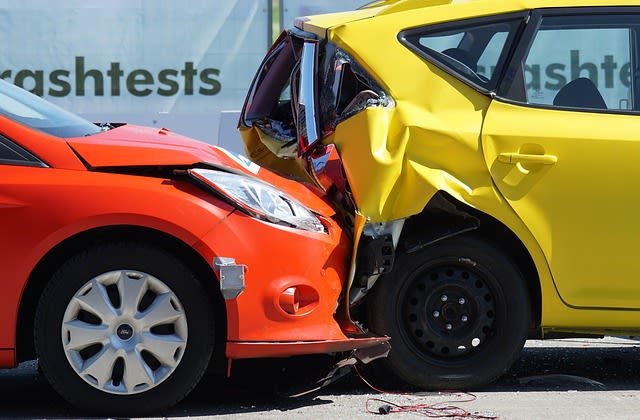
Collisions between particles (molecules, atoms, electrons, etc.) underpin a great deal of what happens in physics and these are often perfectly elastic provided, that is, they collide at low enough speeds. If speeds are too high, we get chemical changes or, in specially built particle colliders, nuclei are smashed and other dramatic events occur. But in developing our model of the kinetic theory of gases we assume that the collisions betwern the atoms or molecules of a gas are perfectly elastic.
COLLISIONS IN ONE DIMENSION
INELASTIC COLLISIONS
The simplest example of an inelastic collision is when a moving object (such as a car) collides with a stationary object: momentarily they crunch together and then they move off together at the same time. This is a typical situation in vehicle collisions. The system is isolated so the total momentum is unchanged by the collision:
momentum before collision = momentum after collision
mv1 = (M+ m)v2
Suppose the car has a mass of 1000 kg and hits the lorry at a speed of 30 m/s (this is just less than the maximum motorway speed of 70 mph). The lorry has a mass of 9000 kg. Then:
1000 kg × 30 m/s = 10 000 kg × v2
giving v2 = 3 m/s.
The combined vehicles move off at a speed of 3 m/s but the lorry would quickly stop if it was braked. Traffic accident experts can estimate this initial speed of the combined vehicles from measurements made at the site of the accident and hence calculate the speed of the incoming vehicle to see if it was exceeding the speed limit.
Energy changes in an inelastic collision
The incoming vehicle had a kinetic energy ( ½ mv2) of 450 kJ. The combined vehicles move off with a kinetic energy of just 45 kJ. Thus only 10 per cent of the input energy remains as kinetic energy in the motion of the combined vehicles. (Check these values yourself.) The lost kinetic energy has gone to make a lot of noise, but mainly to deform (do work on) and eventually heat the material of the vehicles. Vehicles have design features that minimise both the quantity of this energy delivered to human bodies in the vehicles and the rate at which it is delivered. These features include protective shells, crumple zones, seat belts, collapsible steering wheels and rapid-inflation airbags. How these affect what happens is explained in the ‘Safety first’ box which I will explain later on.

Fotograf: Simon Stein. CC BY SA 2.5
Momentum, force, and energy in a traffic collision
The key relationships involved here are between:
- kinetic energy and work done in deforming structures,
- impulse and change of momentum (defining the force produced).
Imagine a car crashing into a very massive structure such as a concrete wall. The forces acting on the car deform it, doing work. The work done is given by the formula W = Fd, where we simplify a complex situation by considering F to be the average force acting until the car is stopped, and d the distance moved by the centre of mass of the car after the front of the car hits the wall. Some of the car’s kinetic energy is transferred to sound and to small pieces that fly off, but these are tiny compared with the energy transferred to produce the main structural deformation. Thus we can say:
½ mv2 = Fd
For a given car travelling at a given speed, kinetic energy is ‘fixed’. But the force F can be reduced if d can be made larger. There is more about this in the ‘Safety first’ box.
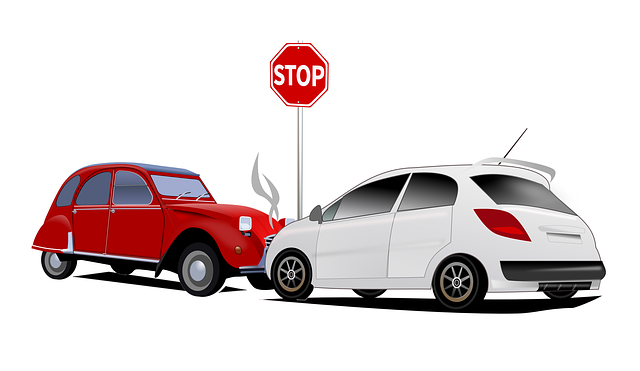
The significance of impulse
Somehow or other, the driver and passengers have to be brought to a stop, and safety features in a car reduce the decelerating forces to as harmless a size as possible. We can best understand the physics of these features by using the concepts of momentum and impulse:
impulse = change of momentum
F Δt = Δ (mv) = m Δv (remember m is constant)
Therefore: F = m Δv / Δt
So, if Δt is made bigger then F gets smaller. F is the force required to change the momentum. In a car collision the human body of mass m is brought to a stop from the collision speed v. The force needed to do this is applied to the body mainly by the seat belt, with some small help from the feet pressing against the floor. We consider the forces involved when a car is braked to a stop in one of the example I will give later. In a graphs showing a force applied to an object that stays steady (a), and one that changes with time (b). How can we calculate the effect of the varying force as an impulse? That is easy. The area under the steady force is simply force × time – it is the impulse produced in Newton seconds (Ns). You can estimate the area under the varying force graph – this will also be the impulse in Ns.
Safety first
It would seem crazy to a rational, impartial observer, from another planet, say, that ordinary human beings, after a short period of training and a simple test, are allowed to get into a metal vehicle capable of speeds of over 150 km/hr. They can then drive them on narrow roads with similar vehicles approaching them at a combined relative speed of 200 km/hr. And that’s if they obey the speed limit. The observer would not be surprised to learn that this behaviour leads to a large number of inelastic collisions. In the European Union alone some 25 000 people die every year in road accidents, equivalent to one jumbo jets crashing a week source. The World Bank and the World Health Organization estimate that in the first 20 years of the twenty-first century, 20 million people will die in such accidents source. For each death, there are between 4 and 12 seriously injured survivors.
Moving objects have momentum: mv. To come to a stop, the object needs a force F applied for a time Δt so that mv = FΔt. Moving objects have kinetic energy Ek = ½ mv2. This energy has to be dissipated when the object comes to a stop.
DESIGNING SAFETY
Car design does its best to ensure that, in an accident, the human beings in a car do not have too much force exerted on them, and that they dissipate their energy of movement in a safe way. Basic precursors to any vehicle design solutions include good road design, speed limits, good driving techniques and simple awareness of other road users. There are three main design features of modern road vehicles that enhance safety in collisions:
- Crumple zones
- Seat belts
- Airbags
Crumple zones were invented by Mercedes engineer Bela Berenyi and were a feature of good car design by 1959. The front and rear parts of a car are designed to absorb the energy of a collision by bending and breaking in a predictable way. As the zone crumples, the time taken by a car to come to a stop also increases. For a given mv, as Δt increases, the force F gets less. The passengers are in a stronger and more rigid compartment (the safety cage) that also slows down more gently. As it does so, the metal frames that support the engine can slide under the passenger compartment.
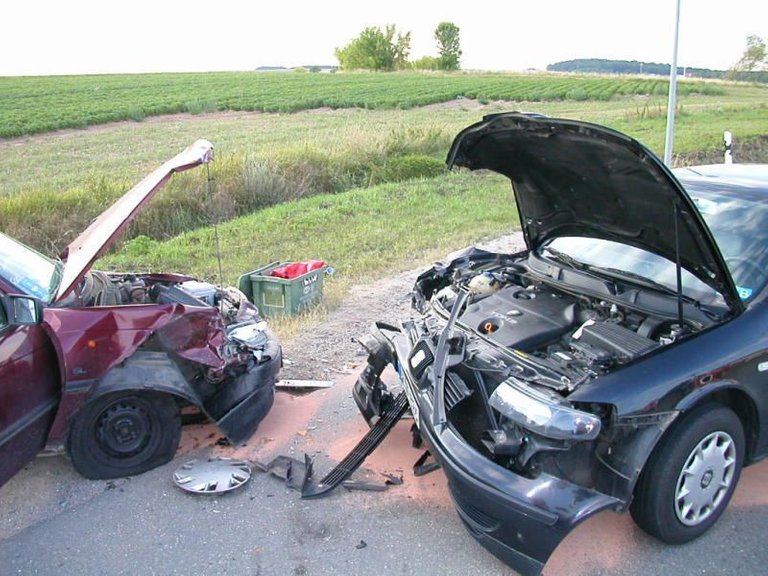
Crumple zones of two vehicles. Feuerwehr Meerane. Public domain
Seat belts were invented by Nils Bohlin at Volvo at about the same time as crumple zones. The three-point seat belt holds the body across the lap and over the chest. When the passenger compartment slows or stops, the human body carries on moving (Newton’s first law) until a force acts to decelerate and stop it. Without a seat belt, this force is provided by the collision with the steering wheel or fascia of the car. If these are rigid, the time of contact is small, the force large. Seat belts restrain the body to the seat and apply the stopping force. The body is still moving forward after the safety cage has stopped, so increasing the stopping time. A perfectly unstretchable seat belt would be almost as bad as not having one at all. The seat belt is designed so that the material stretches enough, without breaking.
So seat belts make good use of the key formula mv = FΔt, but even if the force F is reduced, it still acts over the small area in which it is in contact with the body. This concentration of force can cause damage to bones and tissues. Also, the head is not restrained and can move forward to make damaging contact with the steering wheel or fascia.
Airbags were an addition to and improvement on the seat belt, and protect the head and chest. They were invented in the early 1950s but only became obligatory in road vehicles in 1989. Timing is the key factor in how airbags save lives in a head-on collision. When a collision occurs, there is a sudden large deceleration of the vehicle. This triggers an explosion of gases inside a nylon or other plastic bag. The gases expand the airbag at a rate of 300 km/hr (83 m/s), taking about 40 m/s to inflate fully. At this stage the airbag is rock hard and a head colliding with it would be seriously injured. To avoid this, the airbag immediately starts leaking gas so that, by the time the body makes contact, the bag is comparatively soft. The benefit is twofold: the upper body is brought to a stop slowly and by a larger area, so the force exerted on the body per unit area is lowered to a safe value.
Early airbags used a simple mechanical trigger – a metal ball held inside a tube by a magnet or a spring. A large enough deceleration would let the ball move to touch a contact and complete a circuit for a heating element to trigger the explosion. Current systems are much more elaborate. The deceleration sensor is a MEMS a Micro-Electro-Mechanical System. This is an integrated chip circuit with tiny silicon bars that move as the car decelerates. The chip monitors the movement and senses when the deceleration is large enough to have been caused by a collision, and then triggers the gas explosion.
Airbags can be dangerous. If the body hits them too soon, they can cause injury. Children and small adults tend to sit closer to the airbag and are at greater risk of injury from this effect. The most modern airbag systems include a sensor in the seat which measures the mass and deduces the size of the driver or passenger. This information can be used to limit the rate of expansion and the ultimate internal pressure of the bag. The chemical used in the bag is a solid rocket fuel: sodium azide, NaN3. When heated to 300 °C it decomposes to produce nitrogen gas, which fills the airbag, and sodium metal. Sodium is a dangerous element, so other chemicals are used to soak up the sodium and indeed convert it into a harmless silicate.
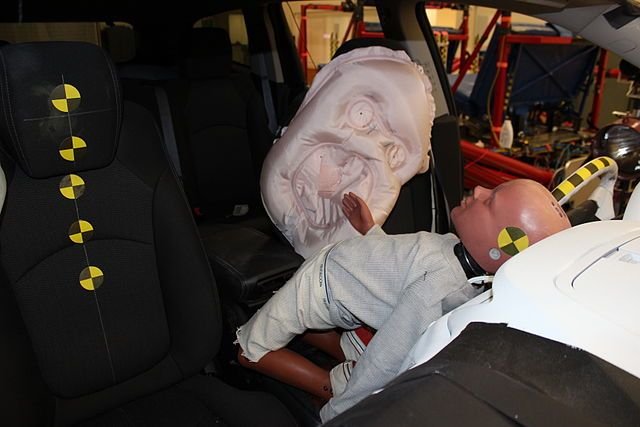
EXAMPLE
Estimate the size of the force needed to stop the driver of a car when the car is braked to a stop from a speed of 13.6 m/s (i.e. 30 mph). The Highway Code assumes that a car travelling at 13.6m/s is stopped at a distance of 14 m by normal braking. (A typical driver has a mass of 65 kg.)
To answer this question, we first need to estimate the time it takes the car to stop; which can be estimated from the relationship:
Distance covered = average speed × time
14 = (13.6 + 0)/2 × t
Giving: t = 2.06 s
Using the impulse = change of momentum relation FΔt = mΔv, we have:
F × 2.06 = 65 × 13.6
F = 429 N
This force is less than the weight (say about 600 N) of the driver, which the feet are quite accustomed to coping with. In a collision, both the car and the driver’s body may be brought to a stop in 0.1 s.
The time has decreased from 2.06 s to 0.1 s, a factor of about 20, so the force is increased by the same factor to 8600 N – over 13 times the body weight.
In practice, things would be more complicated, with some of the force being applied to other parts of the body. For example, unless restrained by a seat belt, the body would pivot round the feet and would hit the steering wheel and/or the windscreen.
ELASTIC COLLISIONS
Imagine two elastic balls of equal mass colliding. The system is isolated, so there is no net change in momentum. That is: momentum before collision = momentum after collision
mv = mv1 + mv2
This formula does not tell us which way the balls move – or their relative speeds.
Suppose v = 10 m/s and the masses m are botlh 1.0 kg. Then:
1.0 kg × 10 m/s = 1.0 kg × v1 + 1.0 kg x v2
which simplifies to:
v1 = 10 m/s – v2 ………………..eqn. 1
We have two unknowns in the equation, and it seems that we could choose any values of the speeds so long as the left-hand side of the equation equalled the right-hand side. But there is another law that applies here – the balls are perfectly elastic, so kinetic energy is conserved:
½ mv2 = ½ mv12 + ½ mv22
We can solve these simultaneous equations by inserting the value of v1 (in terms of v2) from equation 1 and simplifying:
(10)2 = (10 – v2)2 +v22……..………..eqn. 2
This results in the quadratic equation:
v22 – 10v2 = 0……….………eqn. 3
This has two solutions: the speed of the second ball v2 is either 0 or 10 m/s. The solution v2 = 0 is physically impossible: the first ball would have to move through the second at 10 m/s. But the second ball is free to move, and the second solution tells us that this ball will move off with the original speed of the first.
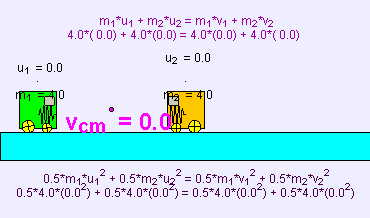
This effect is illustrated by the toy known as Newton’s cradle, but flicking one coin at another on a flat table gives you some idea of the theory. There is no momentum left for the first ball, so it will stop. Simple experiments with steel balls or coins suggest that, when a small mass hits a larger mass at rest, the small mass is likely to bounce back and the large mass to move on. When a large mass collides with a small mass at rest, both move on with the smaller mass having the greater speed. Doing the maths – as above – tells you what exactly happens.
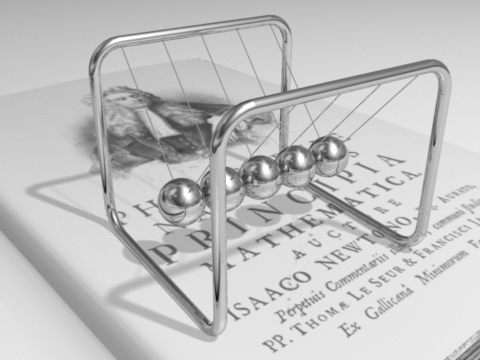
The cradle in motion. DemonDeLuxe, CC BY-SA 3.0.
I will pause here for now. Till next time, I still remain my humble self, @emperorhassy.
Thanks for reading.
REFERENCES
https://www.sparknotes.com/physics/linearmomentum/collisions/section1/
http://hyperphysics.phy-astr.gsu.edu/hbase/col1d.html
https://en.wikipedia.org/wiki/Inelastic_collision
https://opentextbc.ca/physicstestbook2/chapter/inelastic-collisions-in-one-dimension/
https://en.wikipedia.org/wiki/Automotive_safety
https://www.consumerreports.org/cro/2012/04/guide-to-safety-features/index.htm
https://www.ehstoday.com/mag/ehs_imp_35969
http://www.hsa.ie/eng/Your_Industry/Construction/Designing_for_Safety/
https://auto.howstuffworks.com/car-driving-safety/safety-regulatory-devices/crumple-zone.htm
https://en.wikipedia.org/wiki/Crumple_zone
https://en.wikipedia.org/wiki/Seat_belt
https://auto.howstuffworks.com/car-driving-safety/safety-regulatory-devices/airbag.htm
https://en.wikipedia.org/wiki/Airbag
https://www.thoughtco.com/what-is-elastic-collision-2698742
This post has been voted on by the SteemSTEM curation team and voting trail. It is elligible for support from @curie and @minnowbooster.
If you appreciate the work we are doing, then consider supporting our witness @stem.witness. Additional witness support to the curie witness would be appreciated as well.
For additional information please join us on the SteemSTEM discord and to get to know the rest of the community!
Thanks for having used the steemstem.io app and included @steemstem in the list of beneficiaries of this post. This granted you a stronger support from SteemSTEM.